The stories of Philippine mythologies include deities, creation tales, mythical creatures, and living beliefs. Philippine mythology varies among the many ethnolinguistic groups of the Philippines. Some groups during the pre-Spanish conquest era believed in a single Supreme Being who created the world and everything in it, while others chose to worship a multitude of tree and forest deities (diwatas). Diwata comes from the Sanskrit word devata which means “deity“, one of the several significant Hindu influences in the Pre-Hispanic religions of the archipelago. Below are some of the gods and goddesses of the Visayans.

Visayan Deities in Philippine Mythology
The list is divided into regions and then into ethnolinguistic groups. Please click highlighted names to be linked directly to myths or articles regarding them. Sources are mentioned near the top of deity grouping, with more details at the bottom of each section.
WESTERN VISAYAS
Ilonggo (Hiligaynon)
Capiznon
Kinaray-a
Sulod
Ati
WESTERN VISAYAS:
Western Visayas is an administrative region in the Philippines, numerically designated as Region VI. It consists of six provinces (Aklan, Antique, Capiz, Guimaras, Iloilo and Negros Occidental) and two highly urbanized cities (Bacolod and Iloilo City). The regional center is Iloilo City. The region is dominated by the native speakers of four Visayan languages: Kinaray-a, Hiligaynon, Aklanon and Capiznon.
According to the disputed Maragtas documents, ten Bornean datus ‘chieftains’ with their families, escaped from Sultan Makatunaw of Borneo, each on a biniday ‘boat’. They entered Panay through the Suruaga river and landed at a village of the same name, now known as San Joaquin town. They purchased Panay from the Ati/Aeta, whose chief was Marikudo. Datu Puti returned to Borneo; Datu Dumangsol and his wife settled in Barrio Lawag in Suaraga (aka San Joaquin). The couple’s two daughters, Uhay Tanayon and Uhay Salangaon, later married the culture heroes Labaw Dunggon and Paibare. The Bornean migrants cultivated the land and renamed the island Madya-as, which they divided into three sakup: Irong-irong, Aklan (which included the area of Capiz), and Hamtik (now Antique). These sakup were loosely united under a government called Katiringban it Madya-as ‘Confederation of Madya-as’.
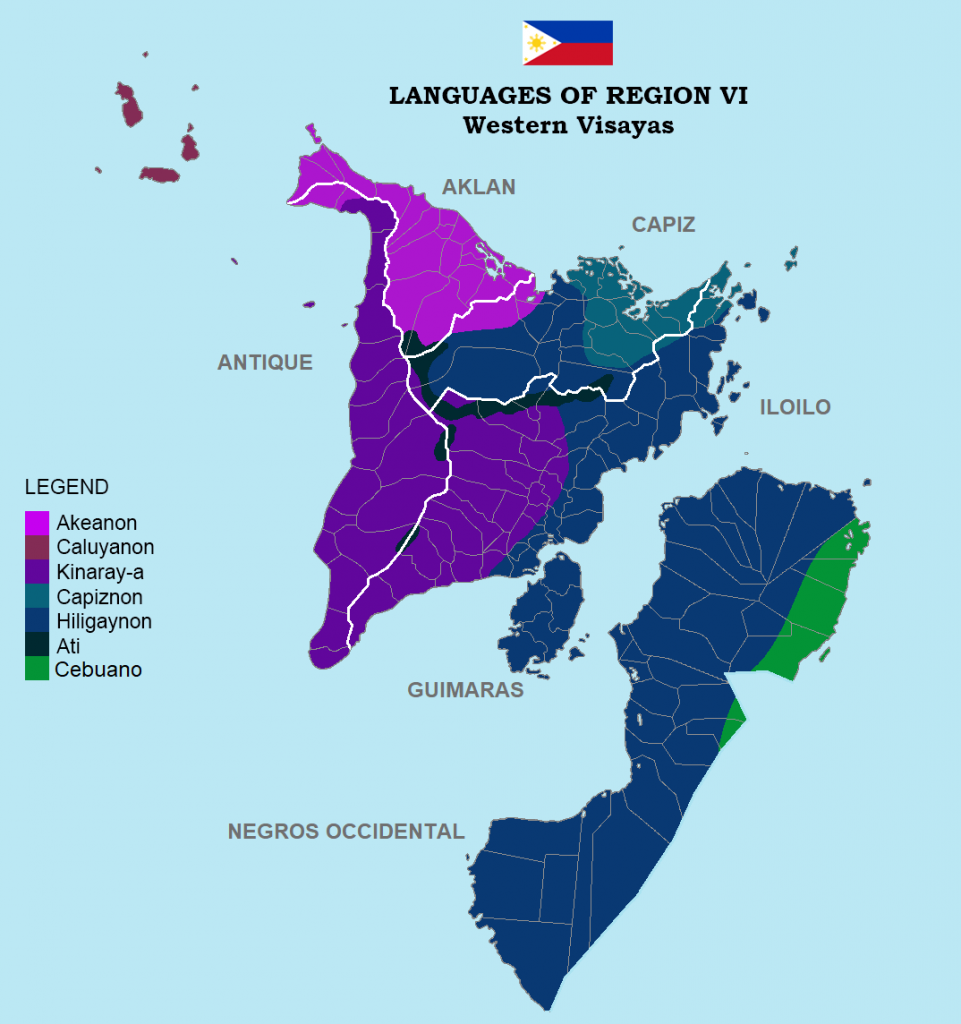
Hiligaynon (Ilongo)
The cultural history of the Hiligaynon is woven out of mythology, archaeology, and documented history. Hiligaynon, also often referred to as Ilonggo, is an Austronesian regional language spoken in the Philippines by about 9.1 million people, predominantly in Western Visayas and Soccsksargen, most of whom belong to the Hiligaynon people.
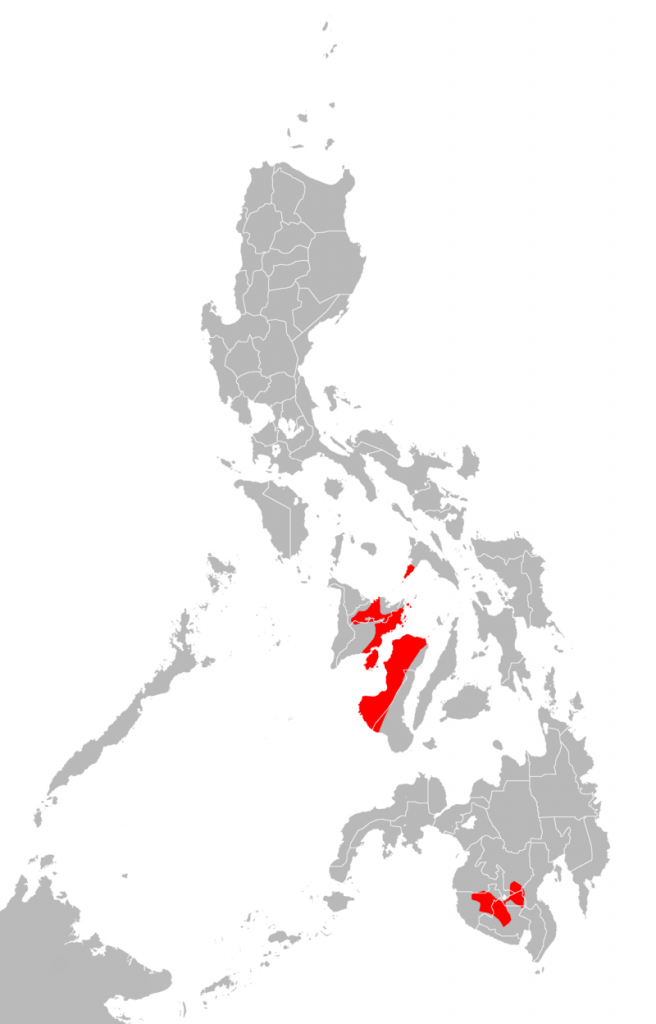
DOCUMENTED BY Felix B. Regalado
Manunubo: the good spirit of the sea
Bulalakaw:god who lives in the sacred Mount Madia-as;malevolent deity in the form of a bird with a flaming tail
DOCUMENTED by F.R. Demetrio
Mama Guayen: a god that carries the souls of the dead in a boat to the ends of the earth;also called Maguayen
DOCUMENTED by F. Landa Jocano
Sumpoy: god who guides the soul toward a very high mountain
Sisiburanen: the god who rules the mountain where Sumpoy drops off the souls of the dead
Hangin: the spirits of the death wind; takes the life of the elderly
DOCUMENTED by Miguel de Loarca; [Arevalo, June, 1582]
Macaptan: god of the earth
Magyawan: god of the sea
Laon: the supreme goddess and creator residing in Mount Kanlaon; governs the harvest, pestilence, and locusts; also referred to as the god Lalaon
DEITIES OF WAR: Balangaw: the rainbow, Inaginid, Makanduk
Sidapa: god who lives in the sacred Mount Madia-as; determines the day of a person’s death by marking every newborn’s lifespan on a very tall tree on Madya-as
Pandaque: god who is given ritual offerings so that a soul of the deceased will not be taken by the gods responsible for torment in the afterlife
Simuran and Siginarugan: gods of the lower regions.
FROM MYTH AND FOLK STORIES:
Canla and Ona: the couple hidden under a clod of earth thrown down by the god Lalaon as punishment to the people who showed malice towards the couple; said to go forth onto the world only after the people become good and envy in the world disappear
Harisaboqued: an emissary of Canla and Ona; Mount Canlaon is said to burst whenever word has been sent from Canla and Ona to Harisaboqued, asking if the people have become good and envy is no longer in this world; in other versions, he is also a king of a prosperous kingdom, where his followers are humans, but in one case, he also has loyal dwarfs as followers; disallowed the people from planting tobacco near the summit, but was disobeyed, resulting in an eruption
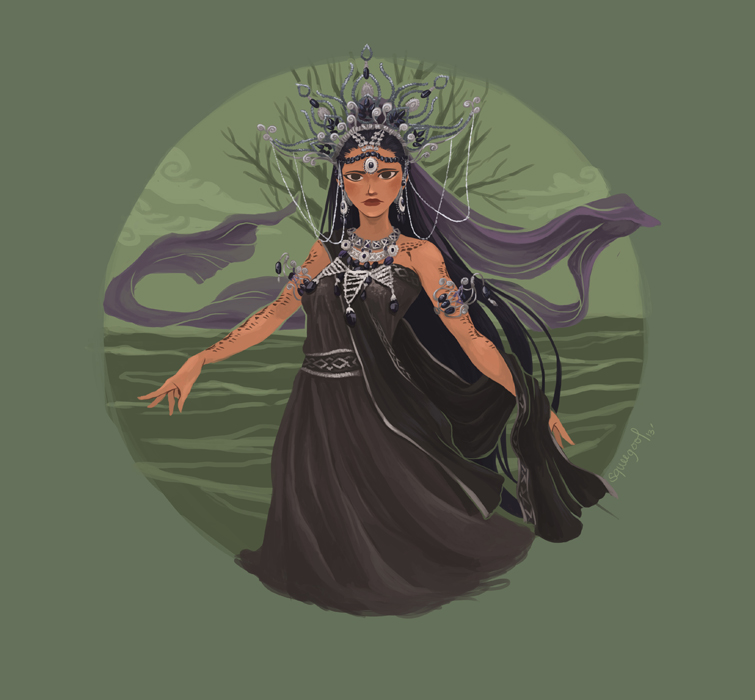
PRIMARY SOURCES:
Demetrio, F. R., Cordero-Fernando, G., & Zialcita, F. N. (1991). The Soul Book. Quezon City: GCF Books.
Loarca, Miguel de. (1582) 1903. Relation of the Filipinas Islands. In Blair and Robertson, The Philippine Islands 5.
Monteclaro, P. A. (1854). Maragtas. English Translation published by University of Michigan.
Rahmann, R. (1974). Philippine Quarterly of Culture and Society Vol. 2, No. 3: The Horn Motif in Mythology and Folklore with Special Reference to the Philippines. University of San Carlos Publications.
Mojares, R. B. (1974). Philippine Quarterly of Culture and Society Vol. 2, No. 3: The Myth of the Sleeping Hero: Three Philippine Cases. University of San Carlos Publications.
Felix B. Regalado, Quintin B. Franco (1973) History of Panay, Central University Philippines
Capiznon
Capiznon is derived from the word kapis, a seashell used to make square panes for windows (and obtained from the mollusk Placuna placenta) and the suffix “non” or “people.” The term refers to the culture, language, and people of Capiz province, one of Panay Island’s four provinces: Iloilo, Capiz, Antique, and Aklan. Capiz is bounded by the Sibuyan Sea on the north, Aklan province on the northwest, Antique province on the west, and Iloilo province on the south and southwest.
Folk history recorded in the Maragtas by Pedro Monteclaro (1907) says ten Bornean datu ‘chieftains’ landed at a site now known as San Joaquin town in Iloilo province. They purchased Panay from the Aeta, cultivated the land, and renamed the island Madya-as. They divided it into three sakup ‘communities’: Irong- Irong, Akean (which included the area of Capiz), and Hamtik (now Antique). These were loosely united under a government called the Katiringban it Madya-as (Confederation of Madya-as).
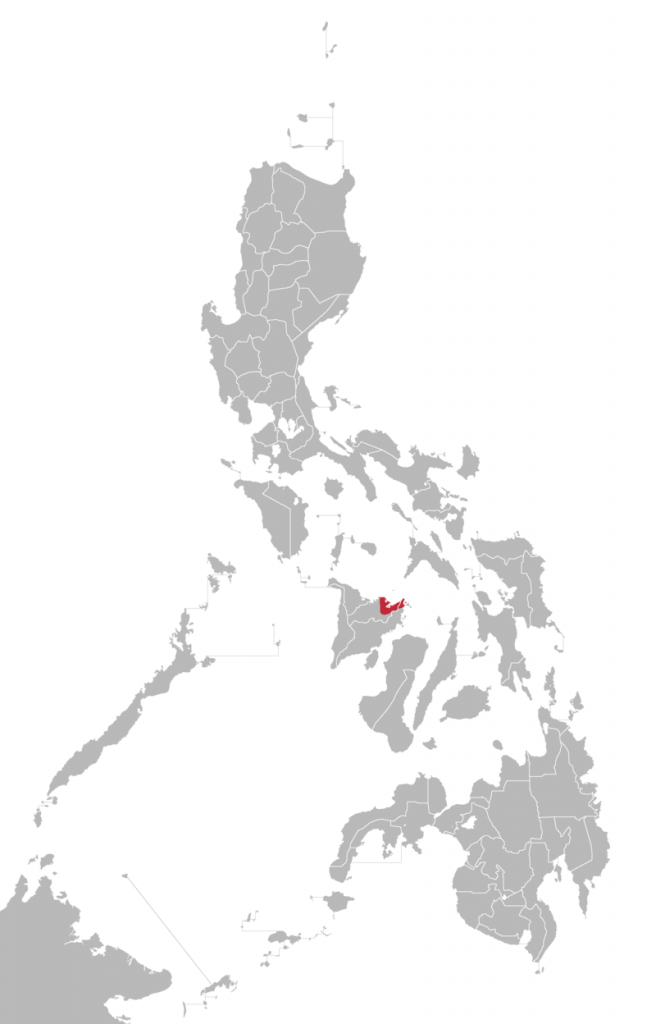
POSSIBLE Deities of past Capiznon. Compiled from other historical sources from surrounding areas by Lucero, R., Pototanon, R. M (2018):
Laon: the supreme deity; a goddess said to reside in the mountain at the neighboring island of Negros
Bulalakaw: a bird god who looks like a peacock and can cause illness; lives in Mount Madja-as
Bangutbanwa: ensures good harvests and an orderly universe
Mangindalon: intercedes for sick persons; punishes enemies
Soliran: one of two performers of the marriage ceremonies
Solian: one of two performers of the marriage ceremonies
Manunubo: the good spirit of the sea
Tungkung Langit: the god of the sky who brings famine, drought, storms, and floods
Lulid-Batang: the god of the earth, responsible for earthquakes and volcanic eruptions
Linting Habughabug: the god of lightning, whose look kills people and who shouts in anger
Launsina: the goddess of the sun, moon, stars, and seas, and the most beloved because people seek forgiveness from her
Burigadang Pada Sinaklang Bulawan: the goddess of greed to whom people pray when they want to get rich
Saragnayan: the god of darkness who has the power to replace brightness with darkness
Lubay-lubyuk Hanginun si Mahuyuk-huyukun: the goddess of the evening breeze; cools people, especially during the summer
Suklang Malayun: the guardian of happy homes
Maklilum-sa-twan: the god of the plains and valleys.
POSSIBLE BELIEF presented by Leothiny Clavel. Based on the similar Bicol Legend:
Agurang: the good spirit who fought against Asuwang
Asuwang: the malevolent spirit who fought against Asuwang
PRIMARY SOURCES:
Lucero, R., Pototanon, R. M. (2018). Capiznon. With contributions by E. Arsenio Manuel. In Our Islands, Our People: The Histories and Cultures of the Filipino Nation
The story of Asuang and Agurang was presented by Clavel, L. S. (1972). The Oral Literature of Capiz. University of the Philippines Diliman.
Kinaray-a
Karay-a, Kinaray-a, or Hiniray-a is derived from iraya meaning “upstream,” ka, meaning “companion,” with infixation in, meaning “to have undergone something.” Karay-a refers to the ethnolinguistic group predominantly located on Panay island in Western Visayas. Chroniclers of the Spanish colonial period refer to them as the “Araya.”
The Karay-a population is concentrated in the province of Antique, which stretches vertically along the entire western coast of Panay island, bounded by the Cuyo East Pass, which is a part of the West Philippine Sea. It is bounded on the east by the Madiaas mountain ranges cutting vertically from north to south. Its three neighboring provinces are Aklan to its northeast, Capiz to the east, and Iloilo to the southeast.
The deities and characters from the Karay-a are probably most well noted for their appearances in the sugidanon epics of Panay. First documented in the 1950s by anthropologist Felipe Landa Jocano, the sugidanon (from Kinaray-a sugid, to tell) tells a story in ten chapters of powerful noblemen, demi-goddesses, and mythical creatures. It is still recited and taught to this day, in chanting sessions that can last for hours at a time.
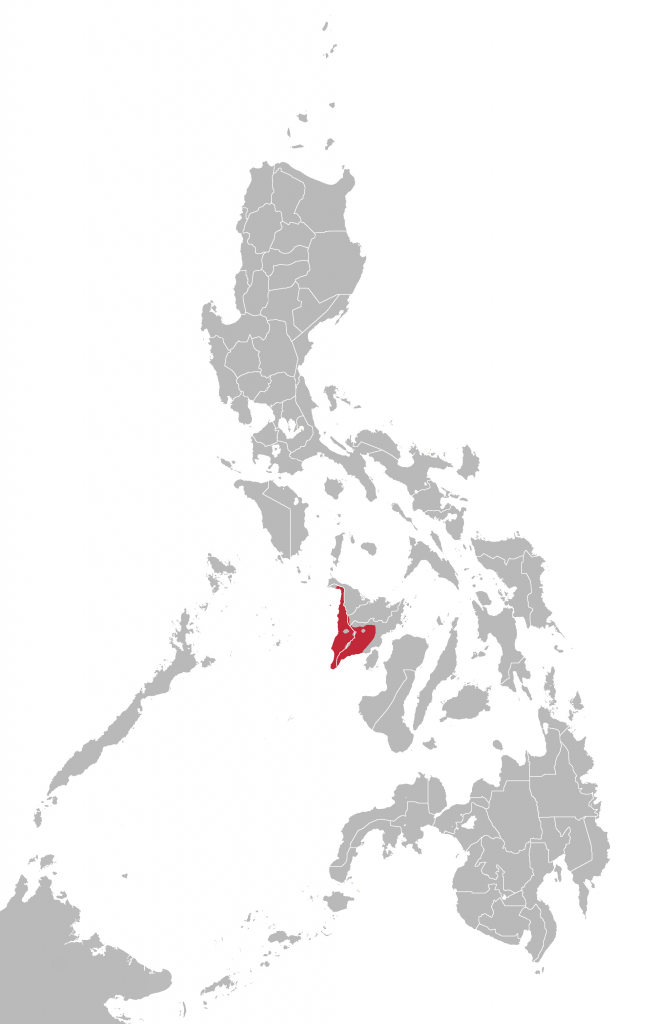
DOCUMENTED by Dr. Alicia Magos, Kinaray-a Village in Antique (1992):
Maka-ako:the supreme deity residing on the uppermost level of the cosmic universe’s seven layers
Kahanginan: These are spirits of the air or spirits inhabiting the hangin (“air”) or the space above the earth’s surface. Only two spirit beings are recognized by the villagers in this category, the bentohangin and the hubot. The former appears like a flying horse, and the latter is a huge bird with wings that look like a huge umbrella from a distance.
Lupan-on: These are spirit beings that dwell on the land or lupa. They are the most numerous and with whom the villagers are in contact. These are known by various names: tamawo, kama-kama, muwa, burulakaw, murokpok, mangingilaw, mantiw, kapri, sigbin, bawa, mulang, and aswang sa talon.
Idalmunon: These are underground spirits. They inhabit the bowels (idalmunon comes from the root word “datum” or “deep”) of the earth’s surface. They are found when diggings or excavations are made. They are believed to be very harmful. These underground spirits include such names as the tulayhang, tibsukan and the lolid.
Tubignon: These are spirits inhabiting the bottom of the seas and oceans. The name is derived from the word tubig or water. They have their own kingdom and they can use fishes and other sea animals as messengers for certain purposes.
Characters from THE FIRST PEOPLE OF EARTH Myth
Tagna-an: the creator god and a busalian shaman; the most powerful and versatile of all ma-aram shamans
Hugna-an: the first man; a ma-aram shaman and child of Tagna-an
Humihinahon: the first woman; a ma-aram shaman and child of Tagna-an
Kapapu-an: the pantheon of ancestral spirits from whom the supernatural powers of shamans originated from; their aid enables specific types of shamans to gush water from rocks, leap far distances, create oil shields, become invisible, or pass through solid matter
DEITIES associated to the Binanog Tradition of the Panay Bukidnon:
Bangle: carries the non-liquefied soul across the water; the way he carries the soul differs depending on the soul’s answers to his questions
Bagubu: deity of the stream which follows after the crossing with Bangle
Characters from the SUGIDANON EPICS:
Alunsina: the mother goddess of the Hinilawod epic heroes; aided in the battle against Saragnayon
Laonsina:a sky goddess and grandmother of Nagmalitung Yawa
Unnamed Sky God:a sky god who prevented Balanakon from traveling to Labaw Donggon’s territory
Labaw Donggon: an epic hero who journeyed to many lands
Gimbitinan: a wife of Labaw Donggon; mother of the hero Asu Mangga
Anggoy Doronoon: a wife of Labaw Donggon; mother of the hero Buyung Baranugun
Yawa Sinagmaling: the wife of the lord, Saragnayon; Labaw Donggon fell in love with her, leading to the battle between Labaw Donggon and Saragnayon
Saragnayon: husband of Yawa Sinagmaling; became a mortal after the wild boar which safeguards his immortality was defeated
Asu Mangga: hero son of Gimbitinan and Labaw Donggon; fought Saragnayon for the release of his father
Buyung Baranugun: hero son of Anggoy Doronoon and Labaw Donggon; fought Saragnayon for the release of his father
Humadapnon: an epic hero; brother of Labaw Donggon and husband of Nagmalitung Yawa;aided by an enchanted tree and three messengers birds in the courting of Nagmaliyung Yawa
Nagmalitung Yawa: a powerful binukot who rescued her husband by transforming herself into a man named Buyung Sunmasakay;defeated the thousand army in Tarangban; when her mother Matan-ayon was in old age, a ritual was conducted where Nagmalitung Yawa found out about Humadapnon’s promiscuity; Matan-ayon’s powers were transferred to her, and she ascended into heaven with the aid of her grandmother Laonsina
Malubay Hanginon: a powerful binukot who captured and imprisoned by Humadapnon; defeated by Nagmalitung Yawa under her male form
Paglambuhan: a warrior who was keeping the Timpara Alimuon sacred boat in his fortress; defeated by Nagmalitung Yawa, Humadapnon, and Dumalapdap
Matan-ayon: mother of Nagmalitung Yawa; thinking that Humadapnon has died, makes Nagmalitung Yawa pregnant to compel to her marriage with the revived Paglambuhan; Humadapnon later kills the couple, but is reunited with the revived Nagmalitung Yawa; in the Sugidanon epic, she married the reluctant Labaw Donggon
Dumalapdap: an epic hero; brother of Labaw Donggon
Tikim Kadlum: an enchanted dog that rouses the ire of the monster Makabagting
Datu Paiburong: owner of Tikim Kadlum
Amburukay: married to Labaw Donggon after she consented her golden pubic hair to be used in Labaw Donggon’s kudyapi
Pahagunon: an underworld being who abducts one of Labaw Donggon’s wife, Ayon
Ayon: abducted by Pahagunon after Labaw Donggon transformed into a sea turtle
Giant Crab Master: a master who has a giant crab follower, who aids in the abduction of one of Labaw Donggon’s wives; his loyal crab can transform into an island with betel-nut trees
Sanagnayan: a being whose life-force is in an egg in a lion’s heart; the sister of Matan-ayon is rescued by Labaw Donggon from Sanagnayan
Balanakon: prevented by the god of the sky from sailing into Labaw Donggon’s territory, resulting in a long-drawn battle
DOCUMENTED by Miguel de Loarca; [Arevalo, June, 1582] (*these are possible past beliefs of the Karay-a):
Macaptan: god of the earth
Magyawan: god of the sea
Laon: the supreme goddess and creator residing in Mount Kanlaon; governs the harvest, pestilence, and locusts; also referred to as the god Lalaon
DEITIES OF WAR: Balangaw: the rainbow, Inaginid, Makanduk
Sidapa: god who lives in the sacred Mount Madia-as; determines the day of a person’s death by marking every newborn’s lifespan on a very tall tree on Madya-as
Pandaque: god who is given ritual offerings so that a soul of the deceased will not be taken by the gods responsible for torment in the afterlife
Simuran and Siginarugan: gods of the lower regions.
PRIMARY SOURCES:
Loarca, Miguel de. (1582) 1903. Relation of the Filipinas Islands. In Blair and Robertson, The Philippine Islands 5.
Magos, Alicia P. 1978. “The Ma-aram in a Kiniray-a Society.” Master’s thesis, University of the Philippines, Diliman.
Jocano, F. L. (2000). Hinilawod. Diliman, Quezon City, Philippines : Punlad Research House Inc.
Caballero, Federico “Tuohan,” Teresita “Abyaran” Caballero-Castor, and Alicia P. Magos. 2014. Tikum Kadlum. Sugidanon (Epics) of Panay Series. Quezon City: University of the Philippines Press.
Sulod (Panay-Bukidnon)
The Sulod are the most populous of the varied cultural-linguistic groups inhabiting the mountains of Central Panay; Tapaz, Capiz; Lambuano, Iloilo; and Valderrama, Antique Provinces, who remain relatively unassimilated. They occupy the rugged finger-like slopes along the banks of the river in the interior and higher mountains. Due to the sandwich-like location of their territory, the inhabitants earned the moniker Sulod by their neighbors, which literally means “closet or room”; they’re also called montesses by lowlanders, which means “mountain dwellers”. They speak a dialect that is a combination of Kiniray-a which is characterized by many archaic expressions and Hiligaynon.
Unless mentioned otherwise, these deities were documented by F. Landa Jocano during his work with the Sulod Societies of Panay.
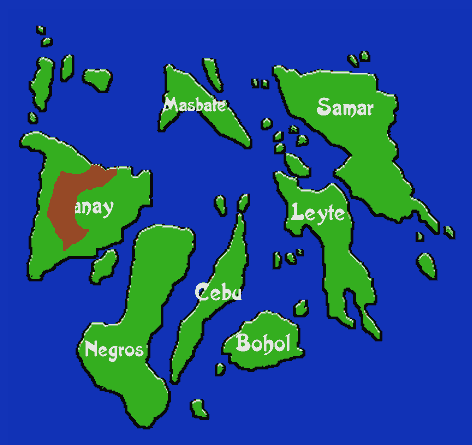
Tungkung Langit: the supreme deity and the most powerful male Diwata; he is of unknown origin, coming from somewhere foreign to the other beings of the Sulod pantheon
Bangun Bangun: the deity of universal time who regulates cosmic movements
Pahulangkug: the deity who changes the seasons
Ribung Linti: the deity of lightning and thunderstorms
Sumalongsong: the deity of the rivers and seas
Santonilyo: the deity of good graces
Munsad Burulakaw: the deity who has direct power over men; most respected and feared in the upperworld
Bayi: one of the two primordial giants who appeared out of nowhere and were responsible for the creation of many things; caught the primordial earthworm and gave birth to the wild animals that inhabit the earth
Laki: one of the two primordial giants who appeared out of nowhere and were responsible for the creation of many things
Primordial Earthworm: an ancient earthworm who excreted the earth after it was caught by the primordial giantess, Bayi.
Paninidngæn: The ability to procreate among women is largely determined by Paninidngæn, the ancestral spirit of pregnancy, who controls the menstrual cycle of the woman: and even if the man is sexually vigorous and fertile, if Paninidngæn causes the woman to menstruate, his ?æræy (sexual fluid) will merely be carried out and no conception takes place. There are other environmental spirits who have influence over the woman’s procreativity. One group of these spirits is known as the mahikawæn. They inhabit open fields and springs. Should the woman’s monthly courses become established and she fails to hold proper rituals, these spirits would cause her abdomen to dry up and she would not bear children.
Tagwati: Sulod omen bird.
SULOD Beliefs Regarding Death
Mangganghaw: keeps track over man’s affairs immediately after marriage; keeps track of pregnancy; he is the first to come to the house of a laboring mother, peeping in the houses to see the child being born, which he then reports to Manglaegas
Manglaegas: enters the house to look for the child to make sure the infant was born alive, then reports to Patag’aes
Patag’aes: awaits until midnight then enters the house to have a conversation with the living infant; if he discovers someone is eavesdropping, he will choke the child to death; their conversation creates the fate of the child, on how long the child wants to live and how the child will eventually die, where the child will always get to choose the answers; once done, Patag’aes takes out his measuring stick, computes the child’s life span, and then departs, sealing the child’s fate
Bangla’e: ferries the souls across Lim’awaen, a deep lake in the underworld; asks the soul how many spouses it had on earth, where the soul is ferried and talked to differently, depending on the answer and the gender of the soul; the soul cannot lie to Bangla’e, as he will summon the tuma, a body louse and the incarnation of the soul’s conscience
Unnamed God: another god that asks questions to the soul
Balagu: guards the bridge of a stream called Himbarawen; asks the same question as Bangla’e to the soul
PRIMARY SOURCES:
Jocano, F. L. (1958). The Sulod: A Mountain People In Central Panay, Philippines. Ateneo de Manila University
Jocano, F. L. (1967). The Sulod Myth of Creation. (M. Antonio, Ed.) Some Aspects of Filipino Vernacular Literature
Jocano, F. L. (1968). Sulod Society. Quezon City: U.P. Press.
Ati of Negros and Panay
The Ati are a Negrito ethnic group in the Visayas, the central portion of the Philippine archipelago. Their small numbers are principally concentrated in the islands of Boracay, Panay and Negros. The Ati, who inhabit the mountain areas of Panay and Negros, are also called ‘Negrito’ (an outdated term). Rahmann and Maceda (1955) believe that ‘Negritos’ of pure blood still exist in northern Negros, although their number is extremely small and continually reduced by intermarriage with lowlanders. The Ati speak Hiligaynon (particularly a variant known as Kiniray-a) and some are fluent in Cebuano.
Magwala: also called Magdili, the supreme spirit
Abog: chief herdsman of wild pigs and deer; the daga or diwata ritual is offered to invite the herdsmen spirits, headed by Abog
Assistants of Abog
Makalisang
Kangil-iran
Spirits of the Forest: the first-fruits sacrifices of the hunt are offered to them through bits of meat, which would bring good luck to the people
Bakero
Tawo-nga-talonon
PRIMARY SOURCE:
Noval-Morales, D. Y. The Ati of Negros and Panay. National Commission for Culture and the Arts.
CENTRAL VISAYAS:
Central Visayas consists of the two major island provinces of Cebu and Bohol, as well as the smaller island of Siquijor and several outlying islands.
Bisaya
Cebuano, also referred to by most of its speakers simply and generically as Bisaya or Binisaya, is an Austronesian language, spoken in the southern Philippines. Specifically, it flourishes in Central Visayas, western parts of Eastern Visayas and on much of Mindanao. Unless specifically mentioned, it is unknown how far certain beliefs were spread among the Bisaya speaking peoples. Much of the documentation and creation myths we rely on did not specify locations.
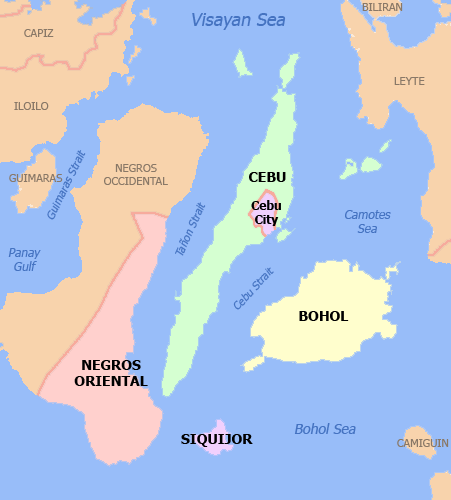
DOCUMENTED by Miguel de Loarca [Arevalo, June, 1582]:
Macaptan: god of the earth
Magyawan: god of the sea
Laon: the supreme goddess and creator residing in Mount Kanlaon; governs the harvest, pestilence, and locusts; also referred to as the god Lalaon
DEITIES OF WAR: Balangaw: the rainbow, Inaginid, Makanduk
Sidapa: god who lives in the sacred Mount Madia-as; determines the day of a person’s death by marking every newborn’s lifespan on a very tall tree on Madya-as
Pandaque: god who is given ritual offerings so that a soul of the deceased will not be taken by the gods responsible for torment in the afterlife
Simuran and Siginarugan: gods of the lower regions.
___________________
START OF BISAYAN DIVINITIES DOCUMENTED BY F. LANDA JOCANO
DIVINITIES UNDER KAPTAN:
Makilum-sa-twan: the god of plains and valleys
Makilum-sa-bagidan: the god of fire
Makilum-sa-tubig: the god of the sea
Kasaray-sarayan-sa-silgan: the god of streams
Magdan-durunoon: the god of hidden lakes
Sarangan-sa-bagtiw: the god of storms
Suklang-malaon: the goddess of happy homes
Alunsina: the goddess of the sky
Abyang: another deity under Kaptan
Maka-ako: also called Laon; the creator of the universe
Linok: the god of earthquakes
Makabosog: a deified chieftain who provides food for the hungry
Sidapa: the goddess of death; co-ruler of the middleworld called Kamaritaan, together with Makaptan
Makaptan: the god of sickness; co-ruler of the middleworld called Kamaritaan, together with Sidapa; he is a brother of Magyan and Sumpoy
DEITIES UNDER SIDAPA AND MAKAPTAN:
Danapolay: the god who supervises the other deities who answer to Sidapa and Makaptan
Tagusirangan
Duwindihan
Dalongdongan
Tagabititlakan-ka-adlaw
Suta
Agta
Tabukuun
Pandaque: messenger of Sidapa; sacrifice is offered to the deity so that a soul can be admitted to the skyworld, Kahilwayan, from the lower world, Kasakitan; lives in Kasakitan, despite being a messenger of Sidapa, who lives in the middleworld, Kamaritaan; also referred as Pandagoy
Magyan: carries the souls of the dead to the lower world, Kasakitan, on his boat called balanday; co-ruler of the lower world Kasakitan, together with Sumpoy; he is a brother of Makaptan and Sumpoy
Sumpoy: takes the souls from Magyan’s balanday and carries them to a place in Kasakitan called Kanitu-nituhan; co-ruler of the lower world Kasakitan, together with Magyan; he is a brother of Magyan and Makaptan
Sisiburanen: ruler of Kanitu-nituhan, a sub-realm of the lower world, Kasakitan; acts as slaver of the souls of those who cannot and have yet go into the skyworld; feeds the souls to Simuran and Siguinarugan after the souls stay in Kanitu-nituhan for years
Kuruntang
Simuran: one of the two giant guards of the gates of Kanitu-nituhan
Siguinarugan: one of the two giant guards of the gates of Kanitu-nituhan;also referred as Siginarugan and Siginarungan
OTHER INHABITANTS OF KASAKITAN:
Abyang Durunuun: the goddess of charms
Saragnayan: the god of darkness who protected his wife, Nagmalitong Yawa Sinagmaling, from all adversaries in Panay mythologies; his source of immortality was inputted on a wild boar, and upon the killing of the boar, he became mortal and was killed by Buyung Baranugon
Pinganun-pinganun: the god of enchanted places
Unmagad Palinti
Sumpay Pako-Pako
Gods of War
Balangaw: the rainbow
Inaginid
Makanduk
END OF BISAYAN DIVINITIES DOCUMENTED BY F. LANDA JOCANO
__________________
The Faithlessness of Sinogo Myth
Kaptan:the supreme god and sky god who fought against Magauayan for eons until Manaul intervened; ruler of the skyworld called Kahilwayan; controls the wind and lightning;in some myths, is married to Maguyaen; also referred as Bathala in one myth;also referred as Abba in one chronicle
Maguayan:the god who rules of the waters as his kingdom; father of Lidagat; brother of Kaptan
Dalagan: the swiftest winged giant, armed with long spears and sharp swords
Guidala: the bravest winged giant armed with long spears and sharp swords
Sinogo: the handsomest winged giant armed with long spears and sharp swords; best loved by Kaptan but betrayed his master and was imprisoned under the sea
Maguyaen: the goddess of the winds of the sea
Magauayan: fought against Kaptan for eons until Manaul intervened
Manaul: the great bird who dropped great rocks upon the battle of Kaptan and Magauayan, creating islands
HELPERS OF MANAUL: Kanauay, Amihan
BISAYAN Creation Myth
Lidagat: the sea married to the wind; daughter of Maguayan
Lihangin: the wind married to the sea; son of Kaptan
Licalibutan: the rock-bodied son of Lidagat and Lihangin; inherited the control of the wind from his father; initiated the revolt against one of his grandfathers, Kaptan; killed by Kaptan’s rage; his body became the earth
Liadlao: the gold-bodied son of Lidagat and Lihangin; killed by Kaptan’s rage during the great revolt; his body became the sun
Libulan: the copper-bodied son of Lidagat and Lihangin; killed by Kaptan’s rage during the great revolt; his body became the moon
Lisuga: the silver-bodied son of Lidagat and Lihangin; accidentally killed by Kaptan’s rage during her brothers’ revolt; her body fragments became the stars
BISAYAN Bakunawa Myth
Bathala: In this myth, and others around the Visayas, Bathala (Tagalog creator) is sometimes mentioned.
Adlaw: the sun, worshiped by the good
Bulan: the moon, who gives light to sinners and guides them in the night
Bakunawa: the serpent deity who can coil around the world; sought to swallow the seven “Queen” moons, successfully eating the six, where the last is guarded by bamboos
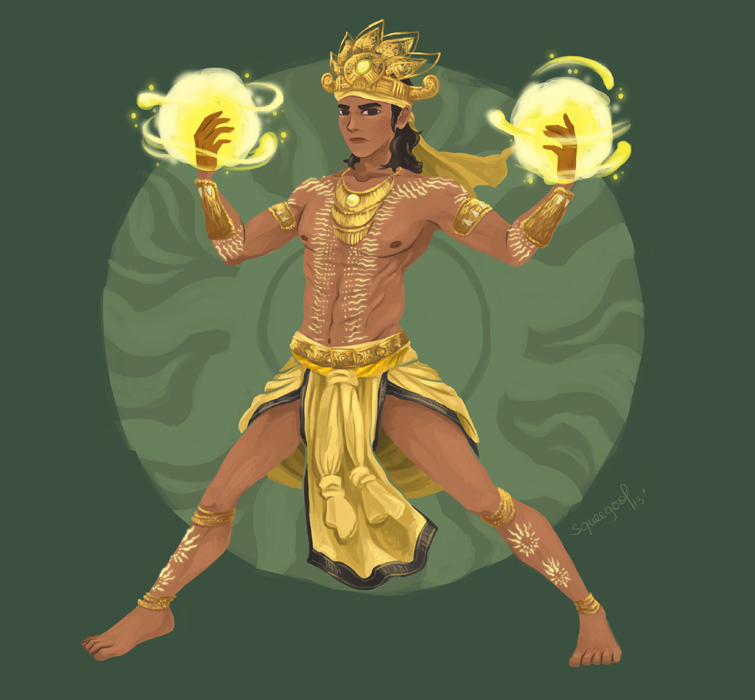
Lalahon: the goddess of fire, volcanoes, and the harvest;also referred as Laon
Santonilyo: a deity who brings rain when its image is immersed at sea; deity of the white men, referring to Spanish colonizers
Gunung: a deity of volcanoes
Magbibaya: a deity similar to the god Magbabaya of the Bukidnon
Lumawig: a deity mentioned in the Aginid
Linug: a deity of earthquakes
Cacao: the goddess of Mount Lantoy who sells her products through a golden ship which can flood rivers
Mangao: husband of Cacao
CHARACTERS FROM CREATION MYTHS:
Sicabay: the first woman
Sicalac: the first man
Libo: the first child and son of Sicabay and Sicalac; was taken south after the defeat of Pandaguan; became the ancestor of a brown-skinned race
Saman: the first daughter and second child of Sicabay and Sicalac; was taken south after the defeat of Pandaguan; became the ancestor of a brown-skinned race
Pandaguan: a younger son of Sicabay and Sicalac; a clever man who invented the fish trap which caught a giant shark; father of Arion; challenged to overpower the gods, and was punished by zapping
Arion: son of Pandaguan who was taken north after the defeat of Pandaguan; became the ancestor of a white-skinned race
Son of Saman and Sicalac: was taken east after the defeat of Pandaguan; became the ancestor of a yellow-skinned race
Sappia: the goddess of mercy originating from the island of Bohol who empties the milk from her breasts onto weeds, giving the origin of white rice; when milk ran out, blood came out from her breast, giving the origin of red rice
Tan Mulong: guardian of a spirit cave where souls may be imprisoned; has a spirit dog with one mammary gland and two genitals
PRIMARY SOURCES:
Jocano, F. L. (1969). Outline of Philippine Mythology. Quezon City: Centro Escolar University
Hill, P. (1934). Philippine Short Stories. Manila: Oriental Commercial Company.
Buyser, F. (1913). Mga Sugilanong Karaan.
Ouano-Savellon, R. (2014). Philippine Quarterly of Culture and Society Vol. 42, No. 3/4: Aginid Bayok Sa Atong Tawarik: Archaic Cebuano and Historicity in a Folk Narrative. University of San Carlos Publications.
Miller, J. M. (1904). Philippine folklore stories. Boston, Ginn.
Loarca, Miguel de. (1582) 1903. Relation of the Filipinas Islands. In Blair and Robertson, The Philippine Islands 5.
Seki, K. (2001). Rethinking Maria Cacao: Legend-making in the Visayan Context. Philippine Studies Journal.
EASTERN VISAYAS:
Eastern Visayas consists of the islands of Leyte, Samar and Biliran. The regional center is Tacloban City.
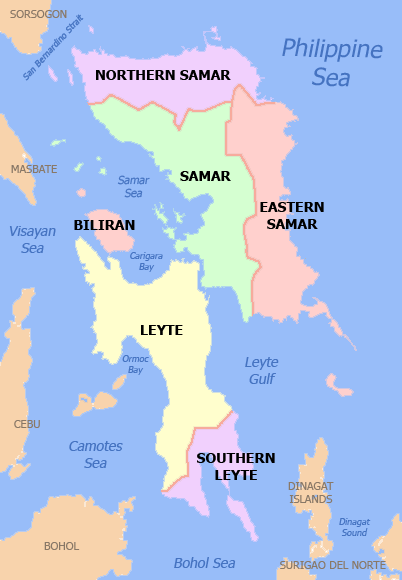
When Magellan reached what is believed to have been Limawasa, the inhabitants of the island worshipped a deity called “Aba”. There is speculation as to who this deity was referring to, and what language they spoke, but it is assumed the lingua franca was Malay. Speculation suggest that Aba may have been referring to Bathala, or was a corruption of Allah.
ABA: From Pigafetta’s account, “Then he asked whether they were Moors or Gentiles, and in what they believed. They answered that they did not perform any other adoration, but only joined their hands, looking up to heaven, and that they called their God, Aba.”
Waray
Waray (also known as Waray-Waray) is an Austronesian language and the fifth-most-spoken native regional language of the Philippines, native to Eastern Visayas. It is the native language of the Waray people and second language of the Abaknon people of Capul, Northern Samar and some Cebuano-speaking peoples of western and southern parts of Leyte island. It is the third most spoken language among the Bisayan languages, only behind Cebuano and Hiligaynon. The Warays are descendants of the Austronesian-speaking immigrants who came to the Philippines during the Iron Age. In 1521, the Warays were the very first Filipinos to be sighted by Europeans under the leadership of Ferdinand Magellan. The Warays were among the first Filipinos converted to Christianity.
Makapatag-Malaon: the supreme deity with both male and female aspect; the male aspect is Makapatag, the leveler who is fearful and destructive, while the female aspect is Malaon, the ancient understanding goddess
Badadum: a guide of the dead; gathers the souls of the newly dead to meet their relatives at the mouth of a river in the lower world
Hamorawan Lady: the deity of the Hamorawan spring in Borongan, who blesses the waters with healing properties
Berbinota: the beautiful goddess who rules the island of Biri, whose formations were made during the battle of the gods
Maka-andog: an epic giant-hero who was friends with the sea spirits and controlled wildlife and fish; first inhabitant and ruler of Samar who lived for five centuries; later immortalized as a deity of fishing
CHARACTERS FROM MYTHS:
Igsabod: one of the 10–11 giant siblings of Maka-andog; friends with the sea spirits
Paula Tomaribo: giant wife and, in some tales, the sibling of Maka-andog; in another tale, she was of Moro origin
Banogbarigos: brother of Maka-andog; became the first aswang
Pagsabihon: one who punishes those who speak of him
Delbora: the one who kaingin farmers offer food; wife of Delalaman
Sanghid: wove cloth on a gold loom with supernatural speed; has the power to move back the sun
Mother of Maka-andog: a gigantic being whose head alone is as large as a hill; lived in Mt. Hurao
Father of Maka-andog: lived in Mt. Hurao in the middle of Samar; more powerful than his sons, including Maka-andog
Tigalhong: brother of Maka-andog; first inhabitant of Leyte
Delalaman: a giant who defeated a priest in a challenge; remained faithful to the old faith, and was never baptised, just like Maka-andog and the other ancestors
Dawisan: one of 9–12 children of Maka-andog who inherited his father’s strength and magic
Yugang: a wife of Maka-andog associated with the gold loom
PRIMARY SOURCES:
Demetrio, F. R., Cordero-Fernando, G., & Zialcita, F. N. (1991). The Soul Book. Quezon City: GCF Books
Myths of the Philippines; Gaverza, J.K., 2014, University of the Philippines Diliman
Mojares, R. B. (1974). Philippine Quarterly of Culture and Society Vol. 2, No. 3: The Myth of the Sleeping Hero: Three Philippine Cases. University of San Carlos Publications
Hart D. V., Hart H. C. (1966). Maka-andog: A Reconstructed Myth from Eastern Samar, Philippines. The Journal of American Folklore
Jordan Clark is a Canadian born descendant of Scottish immigrants living on the homelands of the Lekwungen speaking peoples. His interest in Philippine myth and folklore began in 2004. Finding it difficult to track down resources on the topic, he founded The Aswang Project in 2006. Shortly after, he embarked on a 5 year journey, along with producing partner Cheryl Anne del Rosario, to make the 2011 feature length documentary THE ASWANG PHENOMENON – an exploration of the aswang myth and its effects on Philippine society. In 2015 he directed “The Creatures of Philippine Mythology” web-series, which features 3 folkloric beings from the Philippines – the TIKBALANG, KAPRE and BAKUNAWA. Episodes are available to watch on YouTube. Jordan recently oversaw the editing for the English language release of Ferdinand Blumentritt’s DICCIONARIO MITOLÓGICO DE FILIPINAS (Dictionary of Philippine Mythology) and is working on two more releases with fellow creators scheduled for release later this year. When his nose isn’t in a book, he spends time with his amazing Filipina wife of 20 years and their smart and wonderful teenaged daughter.


